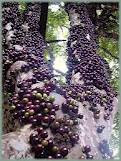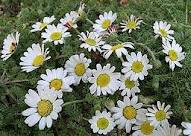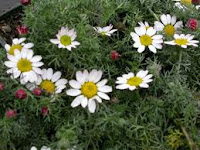Cinquefoil is so named because it has five leaves (cinque=five and folia, leaves). It is also called creeping cinquefoil as it creeps along the ground on tendrils as do strawberries, and five-finger grass or five leaf grass. It is very closely related to Silverweed and is in the same genus Potentilla which implies the herb has strength and power; and is a member of the Rosaceae family which includes fruit trees such as plum, apple, apricot and peach among others.
The plant has been associated with protection from witches, but has also been used in spells and “Witches Ointment” in the Middle Ages. In France Normandy Burgundy Europe and grows rather profusely in Britain
 In the Middle Ages in parts of
In the Middle Ages in parts of  A protection charm could be made by picking a perfect five-fingered leaf on a Wednesday when the moon was waxing and then pressing it in a Bible (one of the heaviest books). The plant could be hung from the bed or door to protect the house and bring a restful sleep, and the leaves were thought to represent health or luck, power, wisdom, love and money.
A protection charm could be made by picking a perfect five-fingered leaf on a Wednesday when the moon was waxing and then pressing it in a Bible (one of the heaviest books). The plant could be hung from the bed or door to protect the house and bring a restful sleep, and the leaves were thought to represent health or luck, power, wisdom, love and money. Its flowers are partially closed in dull weather and completely close at night rather in the same way as wood sorrel does and of course Tickle Me the sensitive plant.
The plant has astringent properties so was used as a remedy for diarrhoea which makes sense because of its tannin content. Like silverweed the roots are also edible and can be boiled having, so it is said a taste similar to chestnuts or parsnips.
Culpeper had this to say of the plant: -
 “It is an especial herb used in all inflammations and fevers, whether infectious or pestilential or, among other herbs, to cool and temper the blood and humours in the body; as also for all lotions, gargles and infections; for sore mouths, ulcers, cancers, fistulas and other foul or running sores.
“It is an especial herb used in all inflammations and fevers, whether infectious or pestilential or, among other herbs, to cool and temper the blood and humours in the body; as also for all lotions, gargles and infections; for sore mouths, ulcers, cancers, fistulas and other foul or running sores. The juice drank, about four ounces at a time, for certain days together, cureth the quinsey and yellow jaundice, and taken for 30 days cureth the falling sickness. The roots boiled in vinegar and the decoction held in the mouth easeth toothache.
The root boiled in vinegar, being applied, heals inflammations, painful sores and the shingles. The same also, boiled in wine, and applied to any joint full of pain, ache or the gout in the hands, or feet or the hip-joint, called the sciatica, and the decoction thereof drank the while, doth cure them and easeth much pain in the bowels.
The roots are also effectual to reduce ruptures, being used with other things available to that purpose, taken either inwardly or outwardly, or both; as also bruises or hurts by blows, falls or the like, and to stay the bleeding of wounds in any part, inward or outward.”
“A sterile woman may have a potion prepared for her by means of the following herbs, viz:—St. John's wort, yew, agrimony, amphibious persicaria, creeping cinque foil, mountain club moss, orpine and pimpernel, taking an emetic in addition.”
 You can make a decoction of the plant with 1½ ounces of the root to 2 pints of water and boil this until the liquid reduces by half. An infusion can be made with 1 ounce of the plant by pouring a pint of boiling water over it and letting this steep for 25 minutes before straining and drinking. If you have used the flowering tops of the plant this is good for menstrual cramps and diarrhoea.
You can make a decoction of the plant with 1½ ounces of the root to 2 pints of water and boil this until the liquid reduces by half. An infusion can be made with 1 ounce of the plant by pouring a pint of boiling water over it and letting this steep for 25 minutes before straining and drinking. If you have used the flowering tops of the plant this is good for menstrual cramps and diarrhoea. Cinquefoil has even made its appearance in English literature and here is one reference to it by John Clare in his poem, “The Eternity of Nature.”
“But flowers, how many own that mystic power,
With five leaves ever making up the flower?
The five-leaved grass, mantling its golden cup
Of flowers – five leaves make all for which I stoop.”
However, as yet the medical profession has done little research on this prolific little plant.
















































